MKT 570: Strategies for Marketing and Promotional Analysis Report
VerifiedAdded on 2022/09/07
|17
|5540
|24
Report
AI Summary
This report provides an executive summary of marketing and promotional strategies, crucial for organizational expansion and achieving communication and sales objectives. It analyzes various promotional strategies, including value/price, competitor-based, quality, problem/solution, benefit, and celebrity-driven positioning, with real-world examples. The report emphasizes the significance of benefit segmentation in market analysis, explores market repositioning, and discusses the impact of changing lifestyles on promotions. It also examines different media scheduling methods and strategies for the implementation of Integrated Marketing Communications (IMC), offering insights into factors affecting success and failure in marketing. The report concludes with a comprehensive overview of the key concepts and strategies discussed, supported by relevant references, to provide a thorough understanding of marketing and promotional practices.

Running head: MKT 570
MKT 570
MKT 570
Paraphrase This Document
Need a fresh take? Get an instant paraphrase of this document with our AI Paraphraser
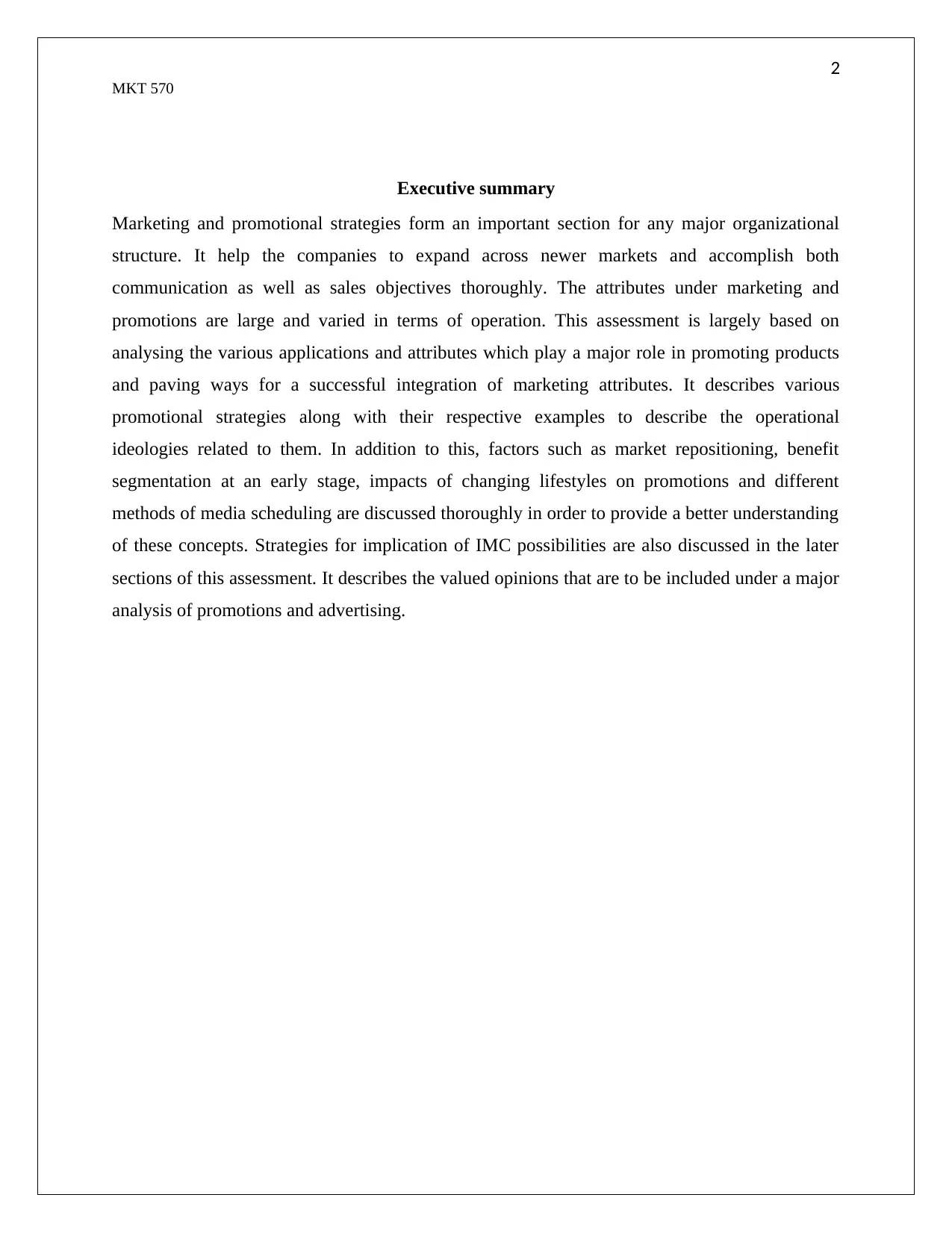
2
MKT 570
Executive summary
Marketing and promotional strategies form an important section for any major organizational
structure. It help the companies to expand across newer markets and accomplish both
communication as well as sales objectives thoroughly. The attributes under marketing and
promotions are large and varied in terms of operation. This assessment is largely based on
analysing the various applications and attributes which play a major role in promoting products
and paving ways for a successful integration of marketing attributes. It describes various
promotional strategies along with their respective examples to describe the operational
ideologies related to them. In addition to this, factors such as market repositioning, benefit
segmentation at an early stage, impacts of changing lifestyles on promotions and different
methods of media scheduling are discussed thoroughly in order to provide a better understanding
of these concepts. Strategies for implication of IMC possibilities are also discussed in the later
sections of this assessment. It describes the valued opinions that are to be included under a major
analysis of promotions and advertising.
MKT 570
Executive summary
Marketing and promotional strategies form an important section for any major organizational
structure. It help the companies to expand across newer markets and accomplish both
communication as well as sales objectives thoroughly. The attributes under marketing and
promotions are large and varied in terms of operation. This assessment is largely based on
analysing the various applications and attributes which play a major role in promoting products
and paving ways for a successful integration of marketing attributes. It describes various
promotional strategies along with their respective examples to describe the operational
ideologies related to them. In addition to this, factors such as market repositioning, benefit
segmentation at an early stage, impacts of changing lifestyles on promotions and different
methods of media scheduling are discussed thoroughly in order to provide a better understanding
of these concepts. Strategies for implication of IMC possibilities are also discussed in the later
sections of this assessment. It describes the valued opinions that are to be included under a major
analysis of promotions and advertising.

3
MKT 570
Table of contents
Introduction......................................................................................................................................4
Different positioning strategies and examples.................................................................................4
Early benefits as a selecting factor for market segments.................................................................7
Marketplace repositioning...............................................................................................................8
Changing lifestyles as opportunities or threats................................................................................9
Differences across communication objectives and sales objectives..............................................10
Methods of media scheduling........................................................................................................10
Relationship between reach, frequency, continuity and the media budge.....................................11
Rational thinking as a support factor.............................................................................................11
Different communication types used under IMC strategies..........................................................12
Required innovations across marketing communication industry.................................................12
Conclusion.....................................................................................................................................12
References:....................................................................................................................................14
MKT 570
Table of contents
Introduction......................................................................................................................................4
Different positioning strategies and examples.................................................................................4
Early benefits as a selecting factor for market segments.................................................................7
Marketplace repositioning...............................................................................................................8
Changing lifestyles as opportunities or threats................................................................................9
Differences across communication objectives and sales objectives..............................................10
Methods of media scheduling........................................................................................................10
Relationship between reach, frequency, continuity and the media budge.....................................11
Rational thinking as a support factor.............................................................................................11
Different communication types used under IMC strategies..........................................................12
Required innovations across marketing communication industry.................................................12
Conclusion.....................................................................................................................................12
References:....................................................................................................................................14
⊘ This is a preview!⊘
Do you want full access?
Subscribe today to unlock all pages.

Trusted by 1+ million students worldwide
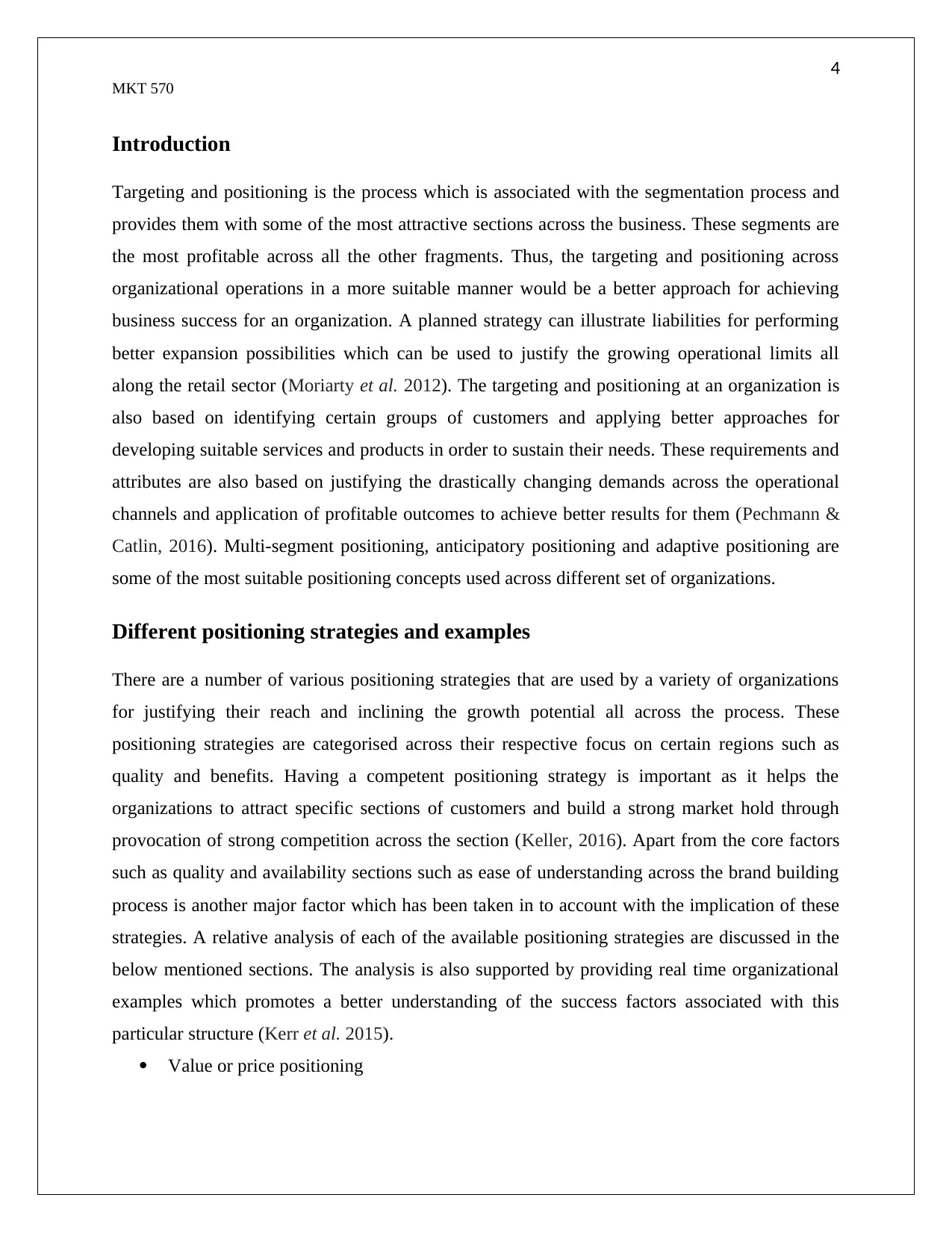
4
MKT 570
Introduction
Targeting and positioning is the process which is associated with the segmentation process and
provides them with some of the most attractive sections across the business. These segments are
the most profitable across all the other fragments. Thus, the targeting and positioning across
organizational operations in a more suitable manner would be a better approach for achieving
business success for an organization. A planned strategy can illustrate liabilities for performing
better expansion possibilities which can be used to justify the growing operational limits all
along the retail sector (Moriarty et al. 2012). The targeting and positioning at an organization is
also based on identifying certain groups of customers and applying better approaches for
developing suitable services and products in order to sustain their needs. These requirements and
attributes are also based on justifying the drastically changing demands across the operational
channels and application of profitable outcomes to achieve better results for them (Pechmann &
Catlin, 2016). Multi-segment positioning, anticipatory positioning and adaptive positioning are
some of the most suitable positioning concepts used across different set of organizations.
Different positioning strategies and examples
There are a number of various positioning strategies that are used by a variety of organizations
for justifying their reach and inclining the growth potential all across the process. These
positioning strategies are categorised across their respective focus on certain regions such as
quality and benefits. Having a competent positioning strategy is important as it helps the
organizations to attract specific sections of customers and build a strong market hold through
provocation of strong competition across the section (Keller, 2016). Apart from the core factors
such as quality and availability sections such as ease of understanding across the brand building
process is another major factor which has been taken in to account with the implication of these
strategies. A relative analysis of each of the available positioning strategies are discussed in the
below mentioned sections. The analysis is also supported by providing real time organizational
examples which promotes a better understanding of the success factors associated with this
particular structure (Kerr et al. 2015).
Value or price positioning
MKT 570
Introduction
Targeting and positioning is the process which is associated with the segmentation process and
provides them with some of the most attractive sections across the business. These segments are
the most profitable across all the other fragments. Thus, the targeting and positioning across
organizational operations in a more suitable manner would be a better approach for achieving
business success for an organization. A planned strategy can illustrate liabilities for performing
better expansion possibilities which can be used to justify the growing operational limits all
along the retail sector (Moriarty et al. 2012). The targeting and positioning at an organization is
also based on identifying certain groups of customers and applying better approaches for
developing suitable services and products in order to sustain their needs. These requirements and
attributes are also based on justifying the drastically changing demands across the operational
channels and application of profitable outcomes to achieve better results for them (Pechmann &
Catlin, 2016). Multi-segment positioning, anticipatory positioning and adaptive positioning are
some of the most suitable positioning concepts used across different set of organizations.
Different positioning strategies and examples
There are a number of various positioning strategies that are used by a variety of organizations
for justifying their reach and inclining the growth potential all across the process. These
positioning strategies are categorised across their respective focus on certain regions such as
quality and benefits. Having a competent positioning strategy is important as it helps the
organizations to attract specific sections of customers and build a strong market hold through
provocation of strong competition across the section (Keller, 2016). Apart from the core factors
such as quality and availability sections such as ease of understanding across the brand building
process is another major factor which has been taken in to account with the implication of these
strategies. A relative analysis of each of the available positioning strategies are discussed in the
below mentioned sections. The analysis is also supported by providing real time organizational
examples which promotes a better understanding of the success factors associated with this
particular structure (Kerr et al. 2015).
Value or price positioning
Paraphrase This Document
Need a fresh take? Get an instant paraphrase of this document with our AI Paraphraser
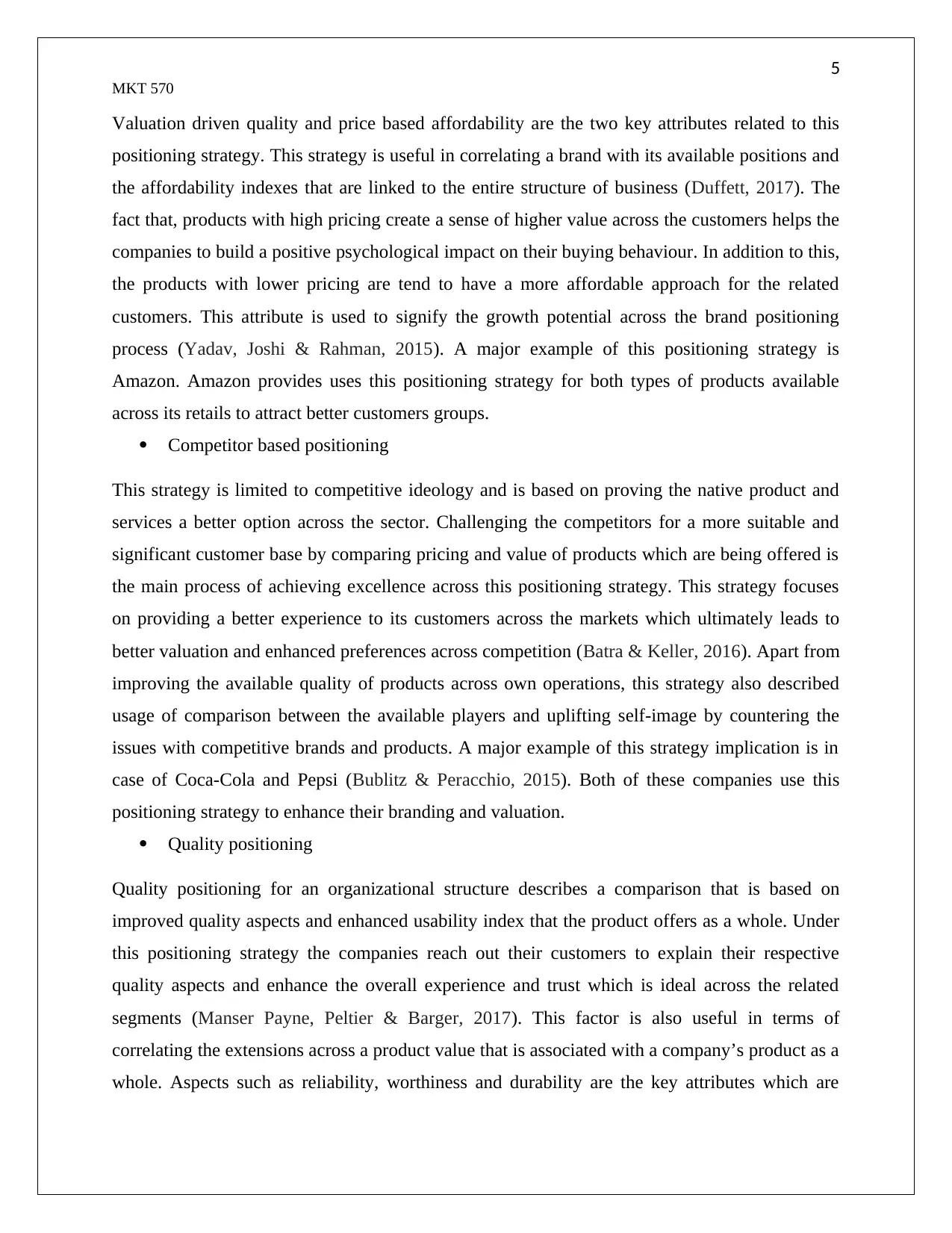
5
MKT 570
Valuation driven quality and price based affordability are the two key attributes related to this
positioning strategy. This strategy is useful in correlating a brand with its available positions and
the affordability indexes that are linked to the entire structure of business (Duffett, 2017). The
fact that, products with high pricing create a sense of higher value across the customers helps the
companies to build a positive psychological impact on their buying behaviour. In addition to this,
the products with lower pricing are tend to have a more affordable approach for the related
customers. This attribute is used to signify the growth potential across the brand positioning
process (Yadav, Joshi & Rahman, 2015). A major example of this positioning strategy is
Amazon. Amazon provides uses this positioning strategy for both types of products available
across its retails to attract better customers groups.
Competitor based positioning
This strategy is limited to competitive ideology and is based on proving the native product and
services a better option across the sector. Challenging the competitors for a more suitable and
significant customer base by comparing pricing and value of products which are being offered is
the main process of achieving excellence across this positioning strategy. This strategy focuses
on providing a better experience to its customers across the markets which ultimately leads to
better valuation and enhanced preferences across competition (Batra & Keller, 2016). Apart from
improving the available quality of products across own operations, this strategy also described
usage of comparison between the available players and uplifting self-image by countering the
issues with competitive brands and products. A major example of this strategy implication is in
case of Coca-Cola and Pepsi (Bublitz & Peracchio, 2015). Both of these companies use this
positioning strategy to enhance their branding and valuation.
Quality positioning
Quality positioning for an organizational structure describes a comparison that is based on
improved quality aspects and enhanced usability index that the product offers as a whole. Under
this positioning strategy the companies reach out their customers to explain their respective
quality aspects and enhance the overall experience and trust which is ideal across the related
segments (Manser Payne, Peltier & Barger, 2017). This factor is also useful in terms of
correlating the extensions across a product value that is associated with a company’s product as a
whole. Aspects such as reliability, worthiness and durability are the key attributes which are
MKT 570
Valuation driven quality and price based affordability are the two key attributes related to this
positioning strategy. This strategy is useful in correlating a brand with its available positions and
the affordability indexes that are linked to the entire structure of business (Duffett, 2017). The
fact that, products with high pricing create a sense of higher value across the customers helps the
companies to build a positive psychological impact on their buying behaviour. In addition to this,
the products with lower pricing are tend to have a more affordable approach for the related
customers. This attribute is used to signify the growth potential across the brand positioning
process (Yadav, Joshi & Rahman, 2015). A major example of this positioning strategy is
Amazon. Amazon provides uses this positioning strategy for both types of products available
across its retails to attract better customers groups.
Competitor based positioning
This strategy is limited to competitive ideology and is based on proving the native product and
services a better option across the sector. Challenging the competitors for a more suitable and
significant customer base by comparing pricing and value of products which are being offered is
the main process of achieving excellence across this positioning strategy. This strategy focuses
on providing a better experience to its customers across the markets which ultimately leads to
better valuation and enhanced preferences across competition (Batra & Keller, 2016). Apart from
improving the available quality of products across own operations, this strategy also described
usage of comparison between the available players and uplifting self-image by countering the
issues with competitive brands and products. A major example of this strategy implication is in
case of Coca-Cola and Pepsi (Bublitz & Peracchio, 2015). Both of these companies use this
positioning strategy to enhance their branding and valuation.
Quality positioning
Quality positioning for an organizational structure describes a comparison that is based on
improved quality aspects and enhanced usability index that the product offers as a whole. Under
this positioning strategy the companies reach out their customers to explain their respective
quality aspects and enhance the overall experience and trust which is ideal across the related
segments (Manser Payne, Peltier & Barger, 2017). This factor is also useful in terms of
correlating the extensions across a product value that is associated with a company’s product as a
whole. Aspects such as reliability, worthiness and durability are the key attributes which are
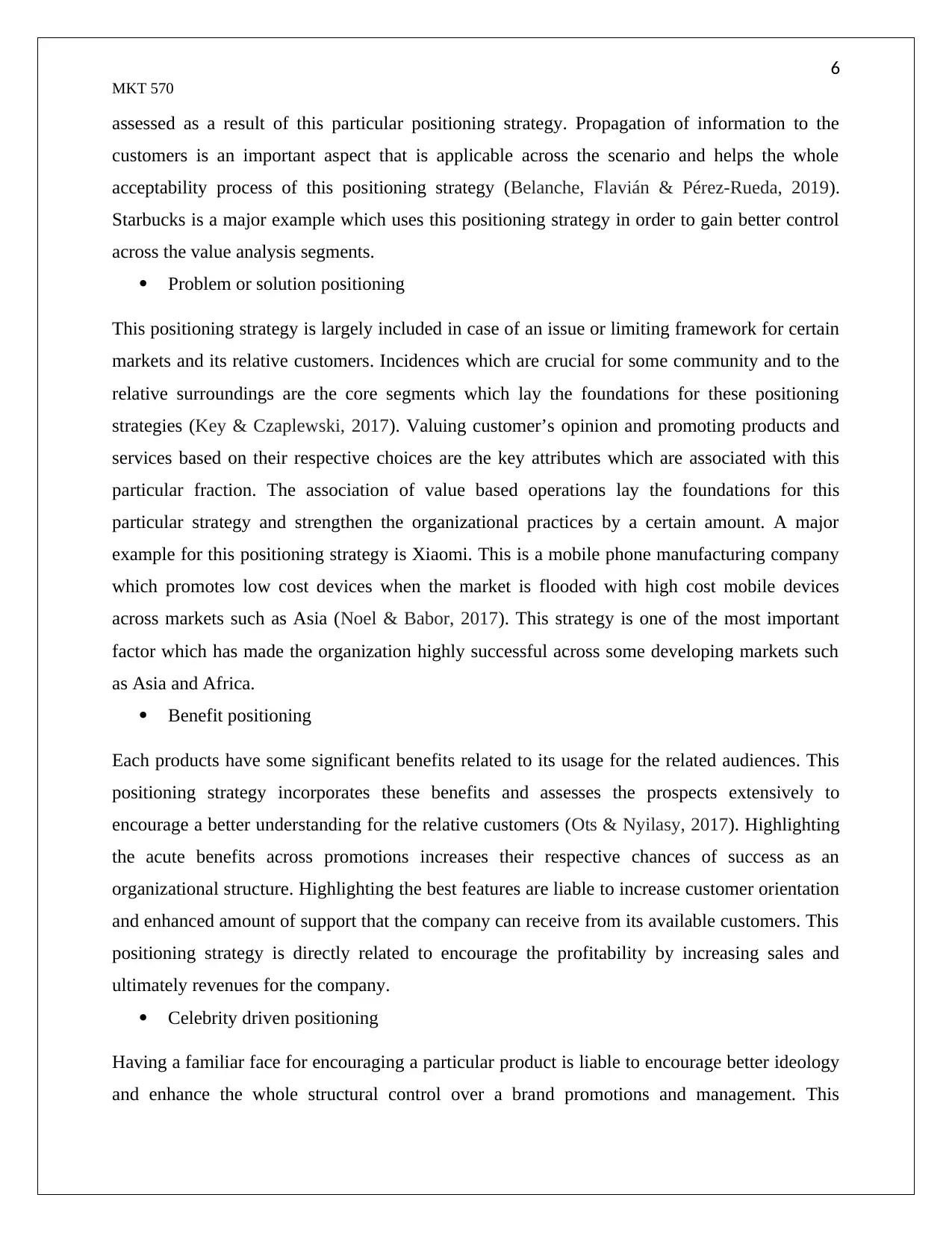
6
MKT 570
assessed as a result of this particular positioning strategy. Propagation of information to the
customers is an important aspect that is applicable across the scenario and helps the whole
acceptability process of this positioning strategy (Belanche, Flavián & Pérez-Rueda, 2019).
Starbucks is a major example which uses this positioning strategy in order to gain better control
across the value analysis segments.
Problem or solution positioning
This positioning strategy is largely included in case of an issue or limiting framework for certain
markets and its relative customers. Incidences which are crucial for some community and to the
relative surroundings are the core segments which lay the foundations for these positioning
strategies (Key & Czaplewski, 2017). Valuing customer’s opinion and promoting products and
services based on their respective choices are the key attributes which are associated with this
particular fraction. The association of value based operations lay the foundations for this
particular strategy and strengthen the organizational practices by a certain amount. A major
example for this positioning strategy is Xiaomi. This is a mobile phone manufacturing company
which promotes low cost devices when the market is flooded with high cost mobile devices
across markets such as Asia (Noel & Babor, 2017). This strategy is one of the most important
factor which has made the organization highly successful across some developing markets such
as Asia and Africa.
Benefit positioning
Each products have some significant benefits related to its usage for the related audiences. This
positioning strategy incorporates these benefits and assesses the prospects extensively to
encourage a better understanding for the relative customers (Ots & Nyilasy, 2017). Highlighting
the acute benefits across promotions increases their respective chances of success as an
organizational structure. Highlighting the best features are liable to increase customer orientation
and enhanced amount of support that the company can receive from its available customers. This
positioning strategy is directly related to encourage the profitability by increasing sales and
ultimately revenues for the company.
Celebrity driven positioning
Having a familiar face for encouraging a particular product is liable to encourage better ideology
and enhance the whole structural control over a brand promotions and management. This
MKT 570
assessed as a result of this particular positioning strategy. Propagation of information to the
customers is an important aspect that is applicable across the scenario and helps the whole
acceptability process of this positioning strategy (Belanche, Flavián & Pérez-Rueda, 2019).
Starbucks is a major example which uses this positioning strategy in order to gain better control
across the value analysis segments.
Problem or solution positioning
This positioning strategy is largely included in case of an issue or limiting framework for certain
markets and its relative customers. Incidences which are crucial for some community and to the
relative surroundings are the core segments which lay the foundations for these positioning
strategies (Key & Czaplewski, 2017). Valuing customer’s opinion and promoting products and
services based on their respective choices are the key attributes which are associated with this
particular fraction. The association of value based operations lay the foundations for this
particular strategy and strengthen the organizational practices by a certain amount. A major
example for this positioning strategy is Xiaomi. This is a mobile phone manufacturing company
which promotes low cost devices when the market is flooded with high cost mobile devices
across markets such as Asia (Noel & Babor, 2017). This strategy is one of the most important
factor which has made the organization highly successful across some developing markets such
as Asia and Africa.
Benefit positioning
Each products have some significant benefits related to its usage for the related audiences. This
positioning strategy incorporates these benefits and assesses the prospects extensively to
encourage a better understanding for the relative customers (Ots & Nyilasy, 2017). Highlighting
the acute benefits across promotions increases their respective chances of success as an
organizational structure. Highlighting the best features are liable to increase customer orientation
and enhanced amount of support that the company can receive from its available customers. This
positioning strategy is directly related to encourage the profitability by increasing sales and
ultimately revenues for the company.
Celebrity driven positioning
Having a familiar face for encouraging a particular product is liable to encourage better ideology
and enhance the whole structural control over a brand promotions and management. This
⊘ This is a preview!⊘
Do you want full access?
Subscribe today to unlock all pages.

Trusted by 1+ million students worldwide
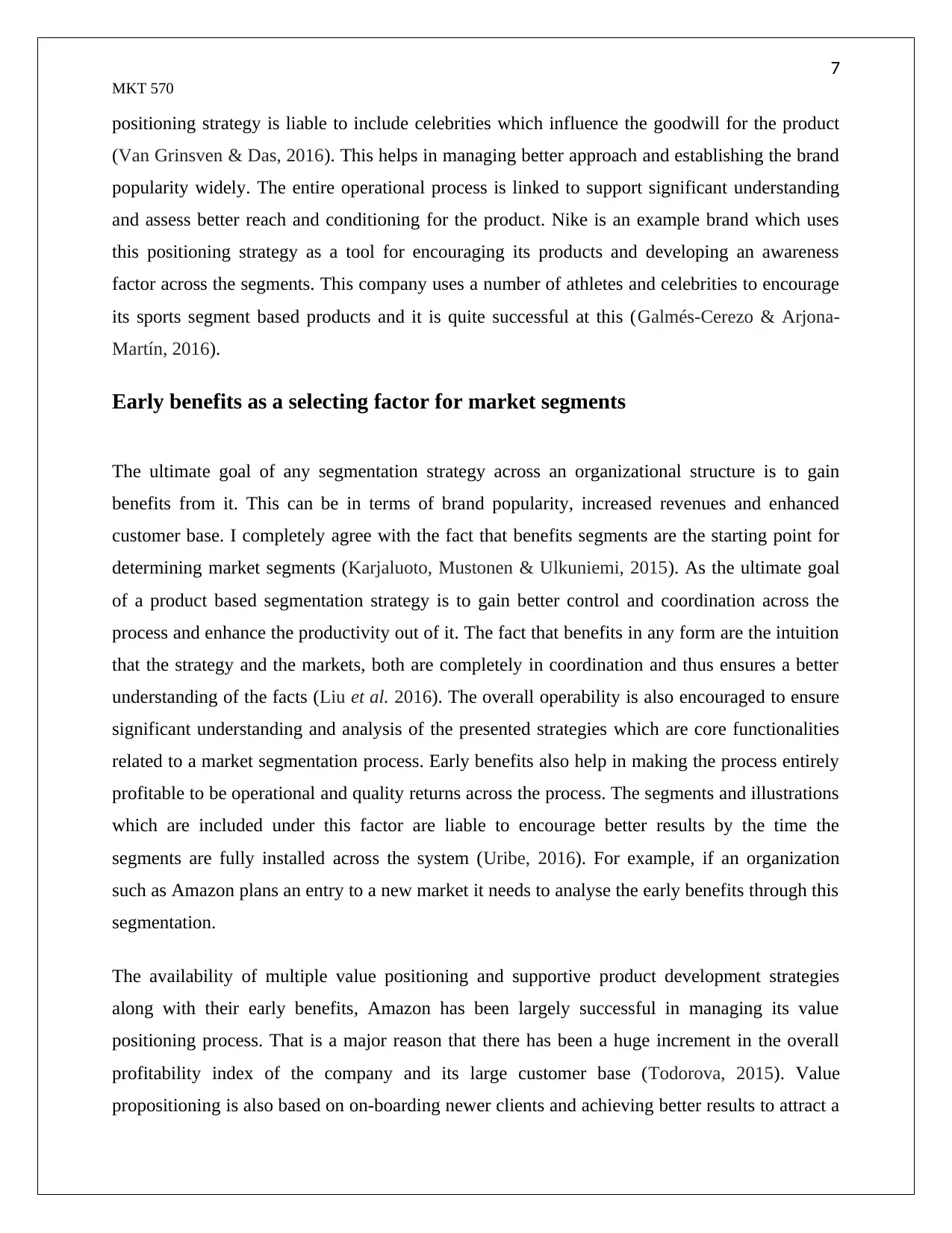
7
MKT 570
positioning strategy is liable to include celebrities which influence the goodwill for the product
(Van Grinsven & Das, 2016). This helps in managing better approach and establishing the brand
popularity widely. The entire operational process is linked to support significant understanding
and assess better reach and conditioning for the product. Nike is an example brand which uses
this positioning strategy as a tool for encouraging its products and developing an awareness
factor across the segments. This company uses a number of athletes and celebrities to encourage
its sports segment based products and it is quite successful at this (Galmés-Cerezo & Arjona-
Martín, 2016).
Early benefits as a selecting factor for market segments
The ultimate goal of any segmentation strategy across an organizational structure is to gain
benefits from it. This can be in terms of brand popularity, increased revenues and enhanced
customer base. I completely agree with the fact that benefits segments are the starting point for
determining market segments (Karjaluoto, Mustonen & Ulkuniemi, 2015). As the ultimate goal
of a product based segmentation strategy is to gain better control and coordination across the
process and enhance the productivity out of it. The fact that benefits in any form are the intuition
that the strategy and the markets, both are completely in coordination and thus ensures a better
understanding of the facts (Liu et al. 2016). The overall operability is also encouraged to ensure
significant understanding and analysis of the presented strategies which are core functionalities
related to a market segmentation process. Early benefits also help in making the process entirely
profitable to be operational and quality returns across the process. The segments and illustrations
which are included under this factor are liable to encourage better results by the time the
segments are fully installed across the system (Uribe, 2016). For example, if an organization
such as Amazon plans an entry to a new market it needs to analyse the early benefits through this
segmentation.
The availability of multiple value positioning and supportive product development strategies
along with their early benefits, Amazon has been largely successful in managing its value
positioning process. That is a major reason that there has been a huge increment in the overall
profitability index of the company and its large customer base (Todorova, 2015). Value
propositioning is also based on on-boarding newer clients and achieving better results to attract a
MKT 570
positioning strategy is liable to include celebrities which influence the goodwill for the product
(Van Grinsven & Das, 2016). This helps in managing better approach and establishing the brand
popularity widely. The entire operational process is linked to support significant understanding
and assess better reach and conditioning for the product. Nike is an example brand which uses
this positioning strategy as a tool for encouraging its products and developing an awareness
factor across the segments. This company uses a number of athletes and celebrities to encourage
its sports segment based products and it is quite successful at this (Galmés-Cerezo & Arjona-
Martín, 2016).
Early benefits as a selecting factor for market segments
The ultimate goal of any segmentation strategy across an organizational structure is to gain
benefits from it. This can be in terms of brand popularity, increased revenues and enhanced
customer base. I completely agree with the fact that benefits segments are the starting point for
determining market segments (Karjaluoto, Mustonen & Ulkuniemi, 2015). As the ultimate goal
of a product based segmentation strategy is to gain better control and coordination across the
process and enhance the productivity out of it. The fact that benefits in any form are the intuition
that the strategy and the markets, both are completely in coordination and thus ensures a better
understanding of the facts (Liu et al. 2016). The overall operability is also encouraged to ensure
significant understanding and analysis of the presented strategies which are core functionalities
related to a market segmentation process. Early benefits also help in making the process entirely
profitable to be operational and quality returns across the process. The segments and illustrations
which are included under this factor are liable to encourage better results by the time the
segments are fully installed across the system (Uribe, 2016). For example, if an organization
such as Amazon plans an entry to a new market it needs to analyse the early benefits through this
segmentation.
The availability of multiple value positioning and supportive product development strategies
along with their early benefits, Amazon has been largely successful in managing its value
positioning process. That is a major reason that there has been a huge increment in the overall
profitability index of the company and its large customer base (Todorova, 2015). Value
propositioning is also based on on-boarding newer clients and achieving better results to attract a
Paraphrase This Document
Need a fresh take? Get an instant paraphrase of this document with our AI Paraphraser
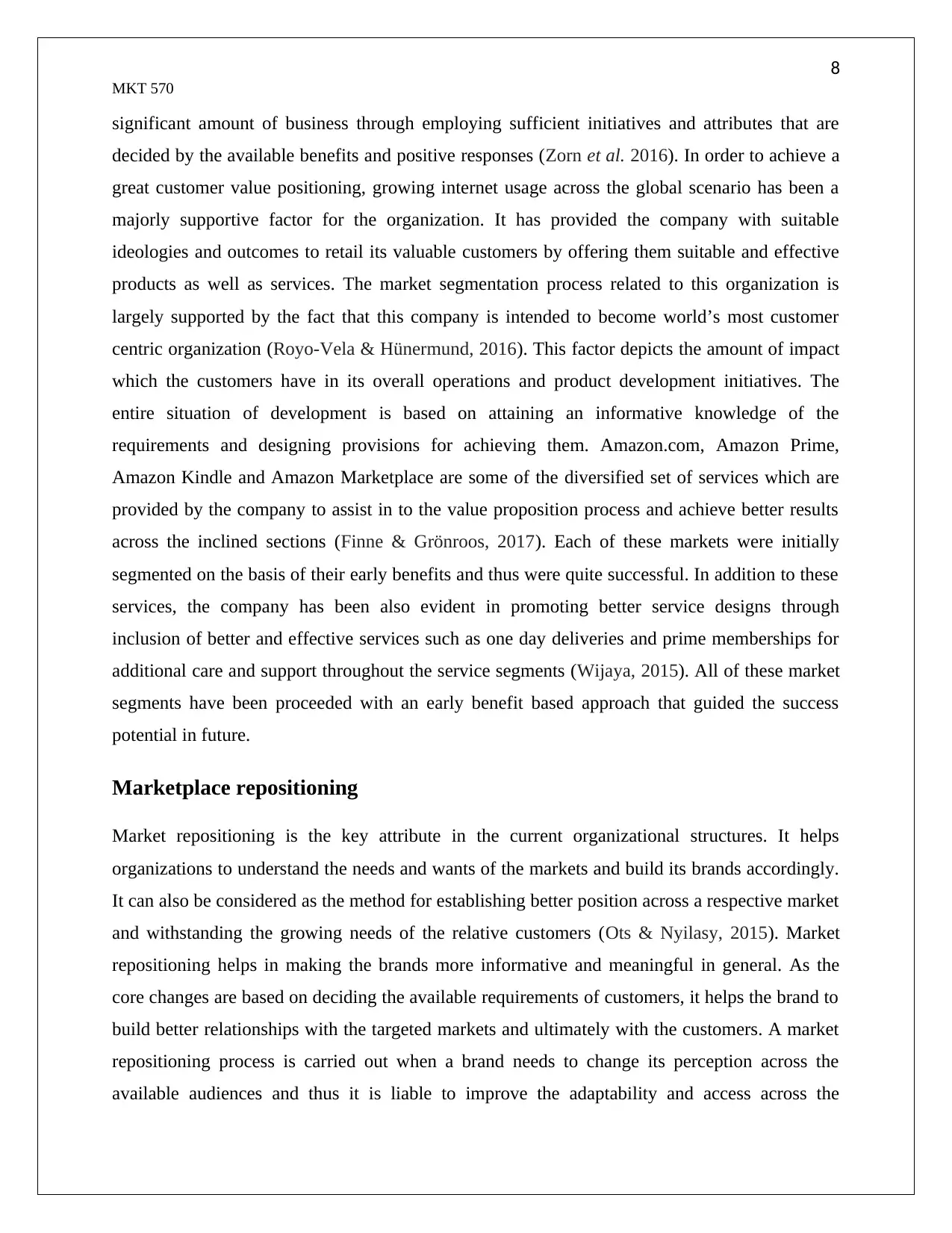
8
MKT 570
significant amount of business through employing sufficient initiatives and attributes that are
decided by the available benefits and positive responses (Zorn et al. 2016). In order to achieve a
great customer value positioning, growing internet usage across the global scenario has been a
majorly supportive factor for the organization. It has provided the company with suitable
ideologies and outcomes to retail its valuable customers by offering them suitable and effective
products as well as services. The market segmentation process related to this organization is
largely supported by the fact that this company is intended to become world’s most customer
centric organization (Royo-Vela & Hünermund, 2016). This factor depicts the amount of impact
which the customers have in its overall operations and product development initiatives. The
entire situation of development is based on attaining an informative knowledge of the
requirements and designing provisions for achieving them. Amazon.com, Amazon Prime,
Amazon Kindle and Amazon Marketplace are some of the diversified set of services which are
provided by the company to assist in to the value proposition process and achieve better results
across the inclined sections (Finne & Grönroos, 2017). Each of these markets were initially
segmented on the basis of their early benefits and thus were quite successful. In addition to these
services, the company has been also evident in promoting better service designs through
inclusion of better and effective services such as one day deliveries and prime memberships for
additional care and support throughout the service segments (Wijaya, 2015). All of these market
segments have been proceeded with an early benefit based approach that guided the success
potential in future.
Marketplace repositioning
Market repositioning is the key attribute in the current organizational structures. It helps
organizations to understand the needs and wants of the markets and build its brands accordingly.
It can also be considered as the method for establishing better position across a respective market
and withstanding the growing needs of the relative customers (Ots & Nyilasy, 2015). Market
repositioning helps in making the brands more informative and meaningful in general. As the
core changes are based on deciding the available requirements of customers, it helps the brand to
build better relationships with the targeted markets and ultimately with the customers. A market
repositioning process is carried out when a brand needs to change its perception across the
available audiences and thus it is liable to improve the adaptability and access across the
MKT 570
significant amount of business through employing sufficient initiatives and attributes that are
decided by the available benefits and positive responses (Zorn et al. 2016). In order to achieve a
great customer value positioning, growing internet usage across the global scenario has been a
majorly supportive factor for the organization. It has provided the company with suitable
ideologies and outcomes to retail its valuable customers by offering them suitable and effective
products as well as services. The market segmentation process related to this organization is
largely supported by the fact that this company is intended to become world’s most customer
centric organization (Royo-Vela & Hünermund, 2016). This factor depicts the amount of impact
which the customers have in its overall operations and product development initiatives. The
entire situation of development is based on attaining an informative knowledge of the
requirements and designing provisions for achieving them. Amazon.com, Amazon Prime,
Amazon Kindle and Amazon Marketplace are some of the diversified set of services which are
provided by the company to assist in to the value proposition process and achieve better results
across the inclined sections (Finne & Grönroos, 2017). Each of these markets were initially
segmented on the basis of their early benefits and thus were quite successful. In addition to these
services, the company has been also evident in promoting better service designs through
inclusion of better and effective services such as one day deliveries and prime memberships for
additional care and support throughout the service segments (Wijaya, 2015). All of these market
segments have been proceeded with an early benefit based approach that guided the success
potential in future.
Marketplace repositioning
Market repositioning is the key attribute in the current organizational structures. It helps
organizations to understand the needs and wants of the markets and build its brands accordingly.
It can also be considered as the method for establishing better position across a respective market
and withstanding the growing needs of the relative customers (Ots & Nyilasy, 2015). Market
repositioning helps in making the brands more informative and meaningful in general. As the
core changes are based on deciding the available requirements of customers, it helps the brand to
build better relationships with the targeted markets and ultimately with the customers. A market
repositioning process is carried out when a brand needs to change its perception across the
available audiences and thus it is liable to improve the adaptability and access across the
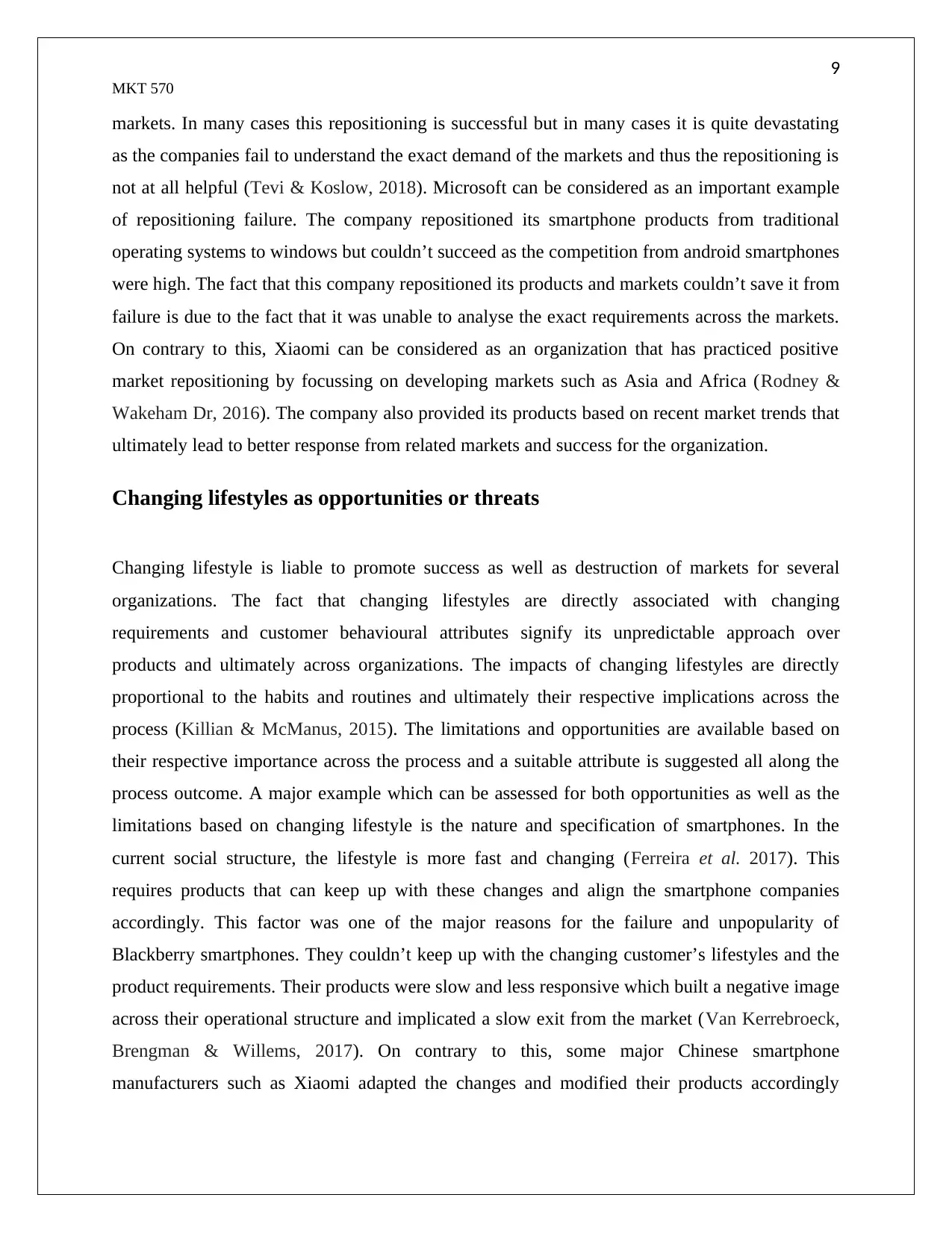
9
MKT 570
markets. In many cases this repositioning is successful but in many cases it is quite devastating
as the companies fail to understand the exact demand of the markets and thus the repositioning is
not at all helpful (Tevi & Koslow, 2018). Microsoft can be considered as an important example
of repositioning failure. The company repositioned its smartphone products from traditional
operating systems to windows but couldn’t succeed as the competition from android smartphones
were high. The fact that this company repositioned its products and markets couldn’t save it from
failure is due to the fact that it was unable to analyse the exact requirements across the markets.
On contrary to this, Xiaomi can be considered as an organization that has practiced positive
market repositioning by focussing on developing markets such as Asia and Africa (Rodney &
Wakeham Dr, 2016). The company also provided its products based on recent market trends that
ultimately lead to better response from related markets and success for the organization.
Changing lifestyles as opportunities or threats
Changing lifestyle is liable to promote success as well as destruction of markets for several
organizations. The fact that changing lifestyles are directly associated with changing
requirements and customer behavioural attributes signify its unpredictable approach over
products and ultimately across organizations. The impacts of changing lifestyles are directly
proportional to the habits and routines and ultimately their respective implications across the
process (Killian & McManus, 2015). The limitations and opportunities are available based on
their respective importance across the process and a suitable attribute is suggested all along the
process outcome. A major example which can be assessed for both opportunities as well as the
limitations based on changing lifestyle is the nature and specification of smartphones. In the
current social structure, the lifestyle is more fast and changing (Ferreira et al. 2017). This
requires products that can keep up with these changes and align the smartphone companies
accordingly. This factor was one of the major reasons for the failure and unpopularity of
Blackberry smartphones. They couldn’t keep up with the changing customer’s lifestyles and the
product requirements. Their products were slow and less responsive which built a negative image
across their operational structure and implicated a slow exit from the market (Van Kerrebroeck,
Brengman & Willems, 2017). On contrary to this, some major Chinese smartphone
manufacturers such as Xiaomi adapted the changes and modified their products accordingly
MKT 570
markets. In many cases this repositioning is successful but in many cases it is quite devastating
as the companies fail to understand the exact demand of the markets and thus the repositioning is
not at all helpful (Tevi & Koslow, 2018). Microsoft can be considered as an important example
of repositioning failure. The company repositioned its smartphone products from traditional
operating systems to windows but couldn’t succeed as the competition from android smartphones
were high. The fact that this company repositioned its products and markets couldn’t save it from
failure is due to the fact that it was unable to analyse the exact requirements across the markets.
On contrary to this, Xiaomi can be considered as an organization that has practiced positive
market repositioning by focussing on developing markets such as Asia and Africa (Rodney &
Wakeham Dr, 2016). The company also provided its products based on recent market trends that
ultimately lead to better response from related markets and success for the organization.
Changing lifestyles as opportunities or threats
Changing lifestyle is liable to promote success as well as destruction of markets for several
organizations. The fact that changing lifestyles are directly associated with changing
requirements and customer behavioural attributes signify its unpredictable approach over
products and ultimately across organizations. The impacts of changing lifestyles are directly
proportional to the habits and routines and ultimately their respective implications across the
process (Killian & McManus, 2015). The limitations and opportunities are available based on
their respective importance across the process and a suitable attribute is suggested all along the
process outcome. A major example which can be assessed for both opportunities as well as the
limitations based on changing lifestyle is the nature and specification of smartphones. In the
current social structure, the lifestyle is more fast and changing (Ferreira et al. 2017). This
requires products that can keep up with these changes and align the smartphone companies
accordingly. This factor was one of the major reasons for the failure and unpopularity of
Blackberry smartphones. They couldn’t keep up with the changing customer’s lifestyles and the
product requirements. Their products were slow and less responsive which built a negative image
across their operational structure and implicated a slow exit from the market (Van Kerrebroeck,
Brengman & Willems, 2017). On contrary to this, some major Chinese smartphone
manufacturers such as Xiaomi adapted the changes and modified their products accordingly
⊘ This is a preview!⊘
Do you want full access?
Subscribe today to unlock all pages.

Trusted by 1+ million students worldwide

10
MKT 570
which helped them gain new markets and huge growth across their revenue segments (Walrave
et al. 2018). This particular example illustrates the issues and advantages based on changing
lifestyles and their implication over organizations.
Differences across communication objectives and sales objectives
Communication objectives are the goals which an organizational structure plans to achieve
across a market segment. It includes aspects such as social media interactions, advertising and
public relations. On the other hand, sales objective are the goals which intent to increase the
overall profitability for the organization. An increment in the sales of a particular product or its
related segments are an example of sales objectives. Both of these fragments are different but
there is a relativity aspect that is associated between them (Wu et al. 2015). The communication
objectives, if achieved properly are evident in promoting the sales objectives and increase their
respective chances of achieving. Communication objectives have a variety of advantages. These
include, increased brand awareness, increased popularity for a particular product or service, on-
boarding new customer groups and increased demand in newer markets. On contrary to this,
some of the disadvantages relate to increased cost of promotions and additional operational
liabilities across the business. On the other hand, sales objectives increase revenue, profitability,
customer spending and investment for further expansion of the business (Turnbull, 2018). The
disadvantage associated with sales objectives relate to increased pressure upon employees in
terms of workload.
Methods of media scheduling
Media scheduling strategies are significantly important for an organization as it helps in creating
a way for success and incorporate better promotions for any organization. Some of the major
media scheduling strategies are discussed in the below mentioned sections.
Brusting strategy
This media scheduling strategy is based on a specific time duration which is mostly during the
initial launch of the products or services. Under this strategy, the companies apply a heavy
advertising process during few months after a product launch and then the frequency decreases.
MKT 570
which helped them gain new markets and huge growth across their revenue segments (Walrave
et al. 2018). This particular example illustrates the issues and advantages based on changing
lifestyles and their implication over organizations.
Differences across communication objectives and sales objectives
Communication objectives are the goals which an organizational structure plans to achieve
across a market segment. It includes aspects such as social media interactions, advertising and
public relations. On the other hand, sales objective are the goals which intent to increase the
overall profitability for the organization. An increment in the sales of a particular product or its
related segments are an example of sales objectives. Both of these fragments are different but
there is a relativity aspect that is associated between them (Wu et al. 2015). The communication
objectives, if achieved properly are evident in promoting the sales objectives and increase their
respective chances of achieving. Communication objectives have a variety of advantages. These
include, increased brand awareness, increased popularity for a particular product or service, on-
boarding new customer groups and increased demand in newer markets. On contrary to this,
some of the disadvantages relate to increased cost of promotions and additional operational
liabilities across the business. On the other hand, sales objectives increase revenue, profitability,
customer spending and investment for further expansion of the business (Turnbull, 2018). The
disadvantage associated with sales objectives relate to increased pressure upon employees in
terms of workload.
Methods of media scheduling
Media scheduling strategies are significantly important for an organization as it helps in creating
a way for success and incorporate better promotions for any organization. Some of the major
media scheduling strategies are discussed in the below mentioned sections.
Brusting strategy
This media scheduling strategy is based on a specific time duration which is mostly during the
initial launch of the products or services. Under this strategy, the companies apply a heavy
advertising process during few months after a product launch and then the frequency decreases.
Paraphrase This Document
Need a fresh take? Get an instant paraphrase of this document with our AI Paraphraser
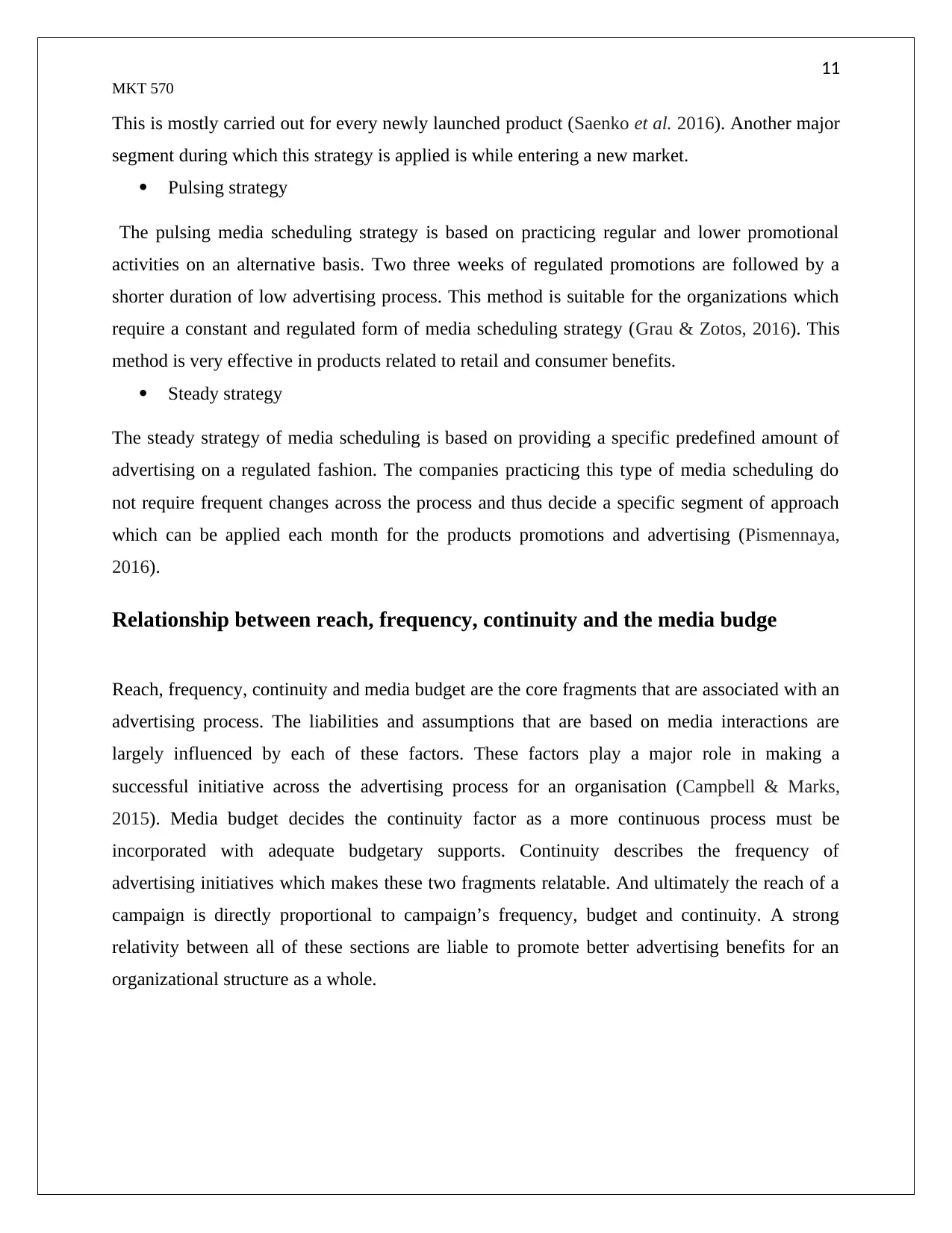
11
MKT 570
This is mostly carried out for every newly launched product (Saenko et al. 2016). Another major
segment during which this strategy is applied is while entering a new market.
Pulsing strategy
The pulsing media scheduling strategy is based on practicing regular and lower promotional
activities on an alternative basis. Two three weeks of regulated promotions are followed by a
shorter duration of low advertising process. This method is suitable for the organizations which
require a constant and regulated form of media scheduling strategy (Grau & Zotos, 2016). This
method is very effective in products related to retail and consumer benefits.
Steady strategy
The steady strategy of media scheduling is based on providing a specific predefined amount of
advertising on a regulated fashion. The companies practicing this type of media scheduling do
not require frequent changes across the process and thus decide a specific segment of approach
which can be applied each month for the products promotions and advertising (Pismennaya,
2016).
Relationship between reach, frequency, continuity and the media budge
Reach, frequency, continuity and media budget are the core fragments that are associated with an
advertising process. The liabilities and assumptions that are based on media interactions are
largely influenced by each of these factors. These factors play a major role in making a
successful initiative across the advertising process for an organisation (Campbell & Marks,
2015). Media budget decides the continuity factor as a more continuous process must be
incorporated with adequate budgetary supports. Continuity describes the frequency of
advertising initiatives which makes these two fragments relatable. And ultimately the reach of a
campaign is directly proportional to campaign’s frequency, budget and continuity. A strong
relativity between all of these sections are liable to promote better advertising benefits for an
organizational structure as a whole.
MKT 570
This is mostly carried out for every newly launched product (Saenko et al. 2016). Another major
segment during which this strategy is applied is while entering a new market.
Pulsing strategy
The pulsing media scheduling strategy is based on practicing regular and lower promotional
activities on an alternative basis. Two three weeks of regulated promotions are followed by a
shorter duration of low advertising process. This method is suitable for the organizations which
require a constant and regulated form of media scheduling strategy (Grau & Zotos, 2016). This
method is very effective in products related to retail and consumer benefits.
Steady strategy
The steady strategy of media scheduling is based on providing a specific predefined amount of
advertising on a regulated fashion. The companies practicing this type of media scheduling do
not require frequent changes across the process and thus decide a specific segment of approach
which can be applied each month for the products promotions and advertising (Pismennaya,
2016).
Relationship between reach, frequency, continuity and the media budge
Reach, frequency, continuity and media budget are the core fragments that are associated with an
advertising process. The liabilities and assumptions that are based on media interactions are
largely influenced by each of these factors. These factors play a major role in making a
successful initiative across the advertising process for an organisation (Campbell & Marks,
2015). Media budget decides the continuity factor as a more continuous process must be
incorporated with adequate budgetary supports. Continuity describes the frequency of
advertising initiatives which makes these two fragments relatable. And ultimately the reach of a
campaign is directly proportional to campaign’s frequency, budget and continuity. A strong
relativity between all of these sections are liable to promote better advertising benefits for an
organizational structure as a whole.
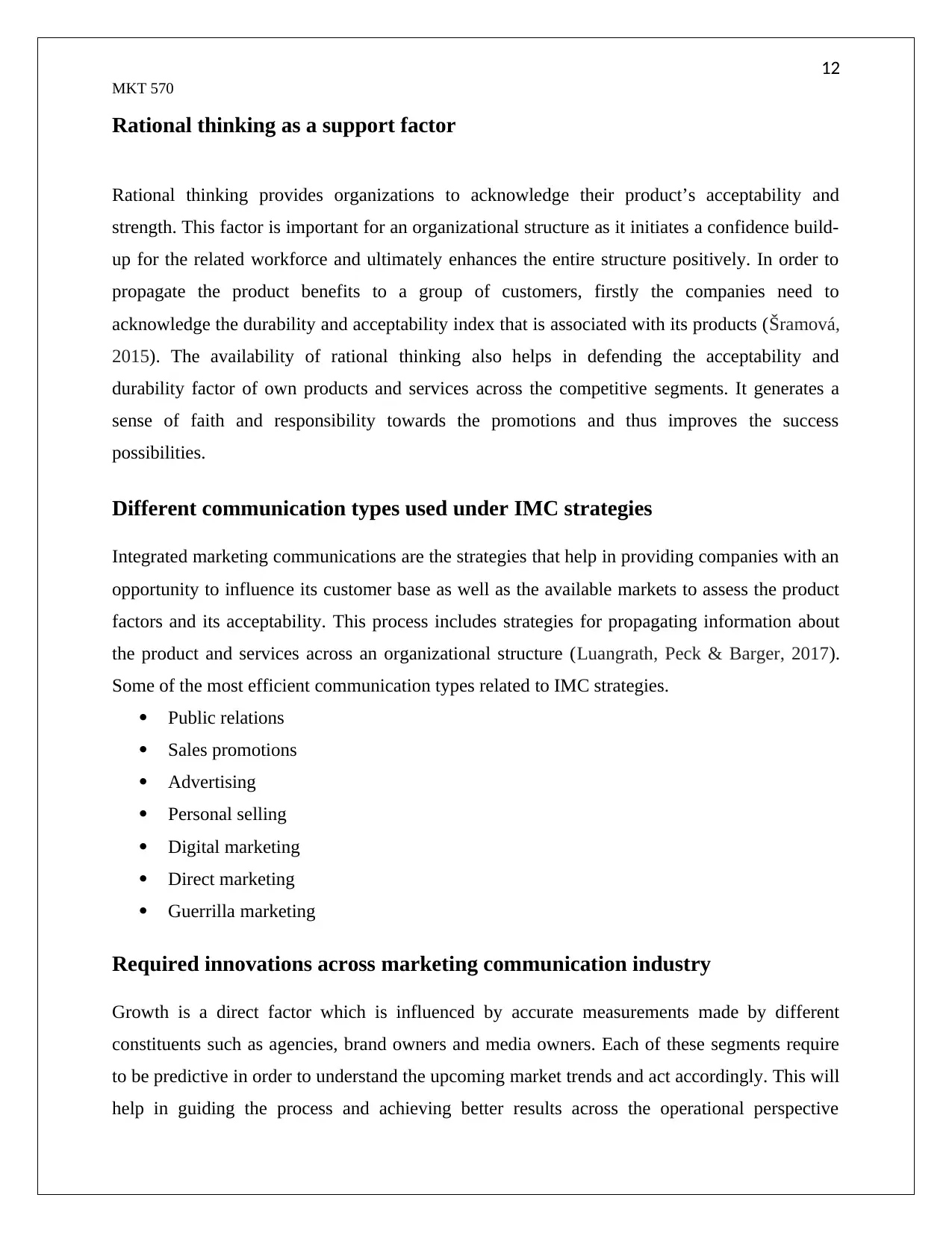
12
MKT 570
Rational thinking as a support factor
Rational thinking provides organizations to acknowledge their product’s acceptability and
strength. This factor is important for an organizational structure as it initiates a confidence build-
up for the related workforce and ultimately enhances the entire structure positively. In order to
propagate the product benefits to a group of customers, firstly the companies need to
acknowledge the durability and acceptability index that is associated with its products (Šramová,
2015). The availability of rational thinking also helps in defending the acceptability and
durability factor of own products and services across the competitive segments. It generates a
sense of faith and responsibility towards the promotions and thus improves the success
possibilities.
Different communication types used under IMC strategies
Integrated marketing communications are the strategies that help in providing companies with an
opportunity to influence its customer base as well as the available markets to assess the product
factors and its acceptability. This process includes strategies for propagating information about
the product and services across an organizational structure (Luangrath, Peck & Barger, 2017).
Some of the most efficient communication types related to IMC strategies.
Public relations
Sales promotions
Advertising
Personal selling
Digital marketing
Direct marketing
Guerrilla marketing
Required innovations across marketing communication industry
Growth is a direct factor which is influenced by accurate measurements made by different
constituents such as agencies, brand owners and media owners. Each of these segments require
to be predictive in order to understand the upcoming market trends and act accordingly. This will
help in guiding the process and achieving better results across the operational perspective
MKT 570
Rational thinking as a support factor
Rational thinking provides organizations to acknowledge their product’s acceptability and
strength. This factor is important for an organizational structure as it initiates a confidence build-
up for the related workforce and ultimately enhances the entire structure positively. In order to
propagate the product benefits to a group of customers, firstly the companies need to
acknowledge the durability and acceptability index that is associated with its products (Šramová,
2015). The availability of rational thinking also helps in defending the acceptability and
durability factor of own products and services across the competitive segments. It generates a
sense of faith and responsibility towards the promotions and thus improves the success
possibilities.
Different communication types used under IMC strategies
Integrated marketing communications are the strategies that help in providing companies with an
opportunity to influence its customer base as well as the available markets to assess the product
factors and its acceptability. This process includes strategies for propagating information about
the product and services across an organizational structure (Luangrath, Peck & Barger, 2017).
Some of the most efficient communication types related to IMC strategies.
Public relations
Sales promotions
Advertising
Personal selling
Digital marketing
Direct marketing
Guerrilla marketing
Required innovations across marketing communication industry
Growth is a direct factor which is influenced by accurate measurements made by different
constituents such as agencies, brand owners and media owners. Each of these segments require
to be predictive in order to understand the upcoming market trends and act accordingly. This will
help in guiding the process and achieving better results across the operational perspective
⊘ This is a preview!⊘
Do you want full access?
Subscribe today to unlock all pages.

Trusted by 1+ million students worldwide
1 out of 17
Related Documents
Your All-in-One AI-Powered Toolkit for Academic Success.
+13062052269
info@desklib.com
Available 24*7 on WhatsApp / Email
![[object Object]](/_next/static/media/star-bottom.7253800d.svg)
Unlock your academic potential
Copyright © 2020–2025 A2Z Services. All Rights Reserved. Developed and managed by ZUCOL.




